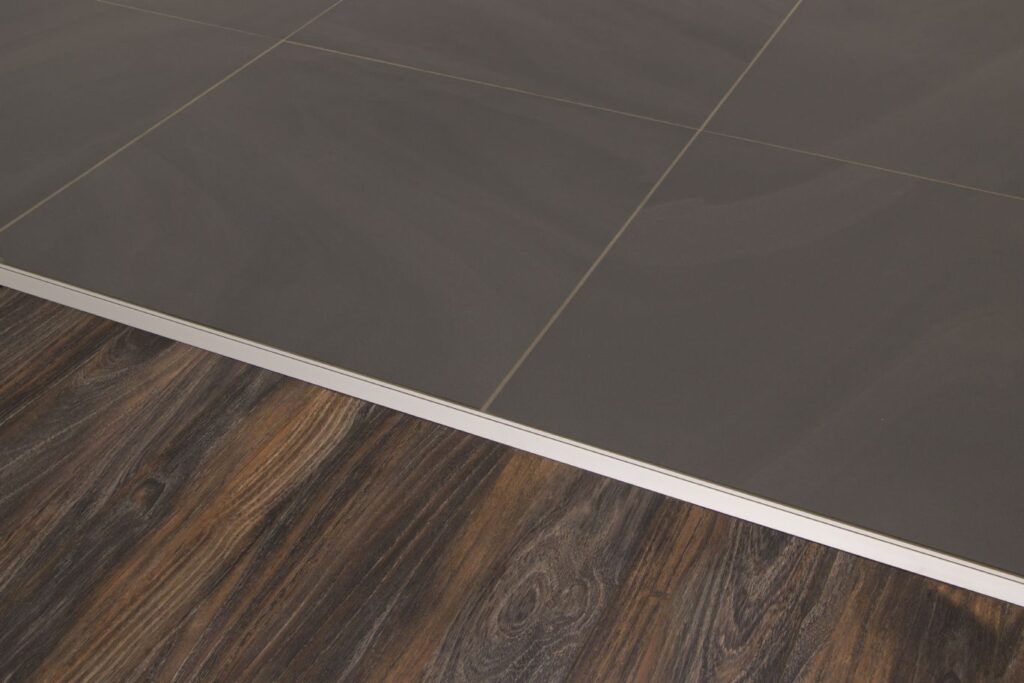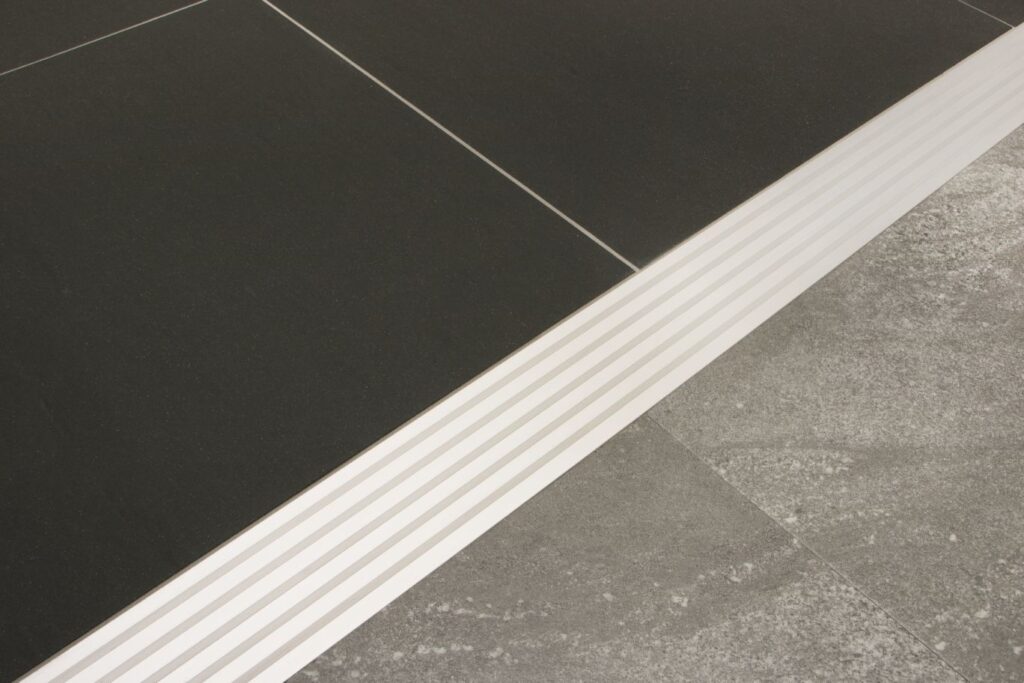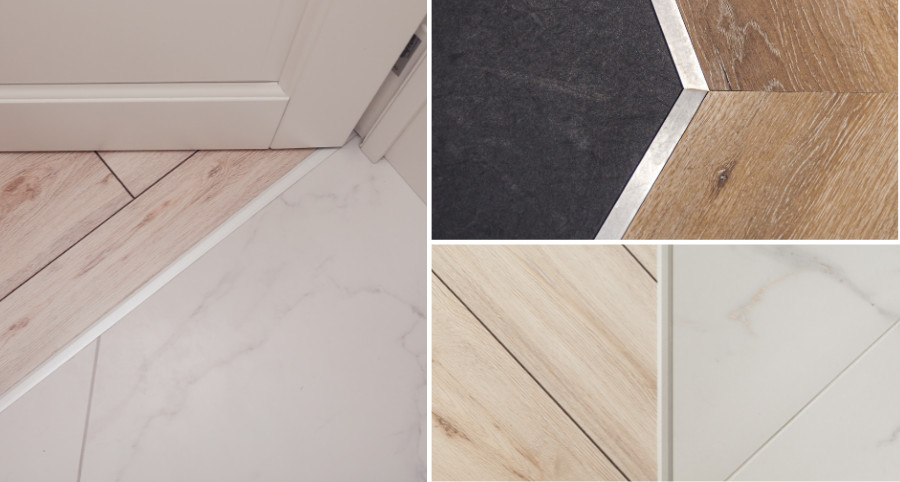In our dream home, our flooring would seamlessly flow from one room to the next. In the real world though, that may not always be possible as different rooms require different flooring. For example, that beautiful solid wood flooring in your living room is not suitable for your bathroom, where as a porcelain or ceramic tile is better suited for those moisture areas. So, how do we transition from one floor to the next to ensure that seamless look throughout? There are several different types of accessories, called transition strips, that are used in the flooring industry to achieve this. But, before we dive into the different accessories, we will look at how transitioning from similar floor products differs from transition between different materials.
Transition Between Similar Materials
Although you may not need a transition strip between materials of the same thickness, you may still want to consider using one. There are two reasons for this. One, seams are incorporated between rooms of similar materials to account for expansion and contraction – The transition strip will cover that gap between rooms. And finally, unless the two different products aesthetically blend together in a pleasing way, you will probably need a transition strip.
Transition Between Different Materials
In this case, a transition strip is almost always required. There could be a couple of reasons for this. One, the materials need some kind of finish along the edge. Two, different materials may not have the same thickness which creates a change in floor heights and changes the underfoot characteristics.
Luckily, these days we are not limited to the aluminum strips we remember from grandma’s house but instead they come in different looks to match your new floor for a more seamless and appealing look. You can now find real hardwood, engineered wood and vinyl transition strips that can be used with a variety of different flooring types.
Carpet to Tile Transition
A carpet to tile transition strip is designed for a low-pile carpet and ceramic tile floor. The aluminum strip is tucked under the edge of the carpet, which grips to the protruding spikes for a secure hold. Ceramic tile butts up against the strip but does not attach to it. Finally, to bridge both floors and cover both edges, a vinyl strip is snapped into the track of the aluminum strip. This method is typically referred to as track & cap and does not only ensures a visually appealing transition but provides stability and durability.
4 In 1 Transition Strip
A 4-in-1 transition strip has interchangeable/adjustable parts that allows it to be used for different flooring types. Your typical 4-in-1 transition strip has a metal channel for mounting and a T-molding to fit into the channel. This is used as a T-molding if the materials are the same height, however it can be modified to accommodate materials with different heights.
Types of 4 in 1 Transition Strips:
- Carpet Strips are used to transition from carpet to another material.
- Hard Surface Reducer is used to transition from a thicker hard surface to a thinner one.
- End Moldings are used to create a final finished edge on one material, rather than transition to another.
A 4 in 1 transition strip is flexible and versatile, making it a popular choice for homeowners and contractors seeking a seamless transition between different flooring materials.

T-Strip for Hard Surfaces
A T-strip is used to link any two hard surface flooring materials of the same height and uses a special sealant. The vertical portion of the T is designed to fit into the gap between the two flooring materials and is bonded with the sealant/adhesive. This top T portion fits snug against the surface of both floors, which provides stability and prevents any movement or separation.

Tile to Laminate Transition
This transition strip is used for joining laminate flooring to tile floor. Tile floor is usually higher than laminate flooring, therefore this transition strip features a molding with offset edges to accommodate the different heights. The strips can be made from unfinished hardwood and can be stained any colour to match your laminate floors or in other cases a standard size is available from the laminate supplier to match the flooring. There are also a variety of Schluter tile edges available that may be used to create the transition to a different height.

Wood to Wood Seam Binder
Typically referred to as “seam binders” they are flat strips of hardwood with beveled edges. It is used to bridge floors of equal heights. It is installed over the seam and is attached to the subfloor with screws. It is not screwed into either floor, which allows the floor to contract and expand without cracking the transition strip. These transition strips are also available in different widths (typically 5 inches) and come unfinished so it can be stained to match your flooring.
Vinyl to Tile Transition
This transition is much like the tile to laminate transition strip. It is made from hardwood and is used to create a smooth transition from a vinyl floor to a thicker tile floor. If a vinyl reducer is being used, a metal channel is anchored to the subfloor, and the top strip is then snapped into the channel to cover the floor seams. A hardwood strip can be used and it can be stained or painted to match your floors or a Schluter tile edge can be installed with the tile to create the transition down to the vinyl flooring.

Carpet Edge Gripper
A carpet edge griper, also known as a naplock, is an aluminum strip designed to hold the edge of the carpet securely in place with metal teeth. Its purpose is to join carpet with any flooring surface that is thinner than the carpet. The gripper is tacked to the subfloor along the edge where the carpet meets the other flooring material, and the carpet is forced into the toothed side of the strip. This not only provides a clean look, but it also prevents the carpet from fraying and lifting at the edges over time. They are available in several colour options, making it easier to achieve a cohesive and visually appealing transition.
Where Should Flooring Meet in a Doorway
Flooring in doorways should ideally meet in the centre, perpendicular to the door’s swing. This alignment creates a seamless transition and prevents tripping hazards. However, depending on the flooring types, structural constraints, and design preferences, flooring transitions can be placed at the edge of the door frame or under the door.
Conclusion
Seamless transitions between flooring materials can elevate not only the functionality of your home but also the look and feel of your space. From traditional aluminum strips to modern options like real hardwood, there are transition strips to suit every need. With the right transition strips and expert advice, you can achieve the perfect transition throughout your home.
For further assistance or to explore our range of transition strips, contact us or visit your nearest Nufloors location today.




